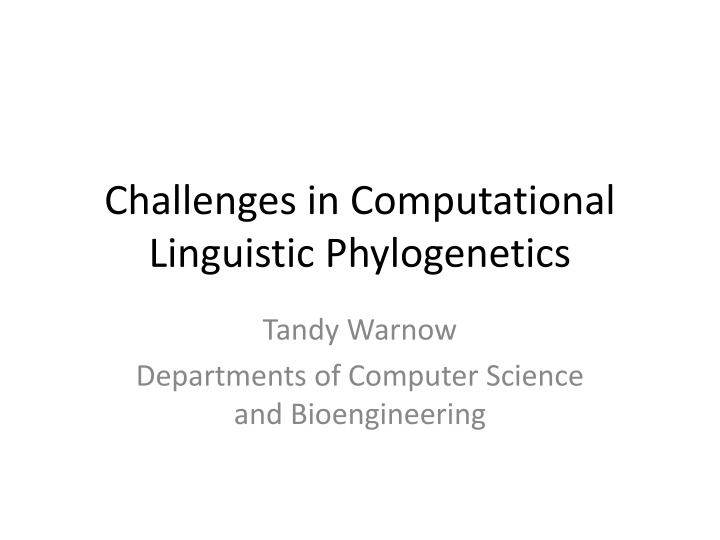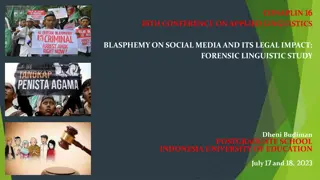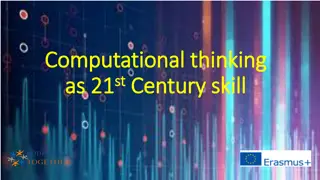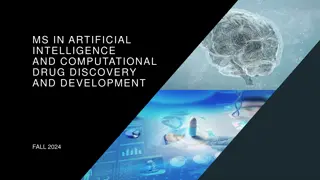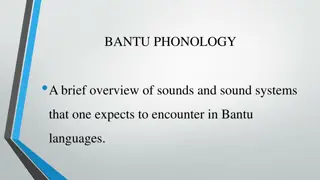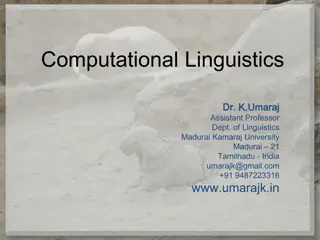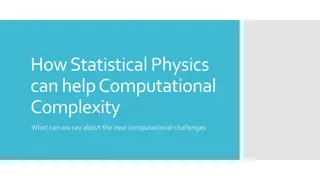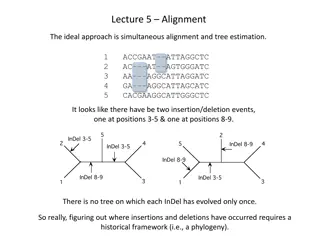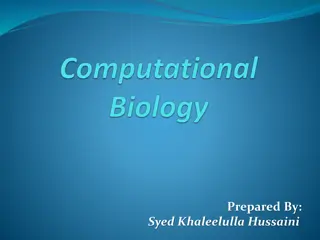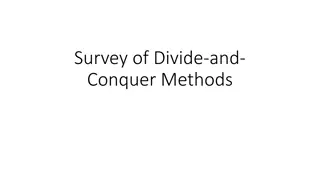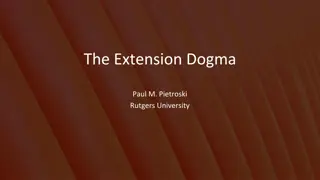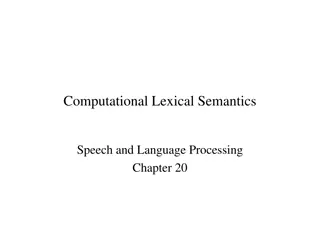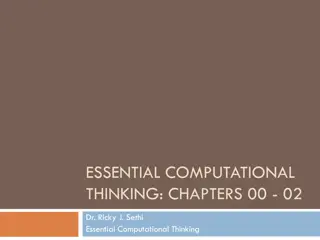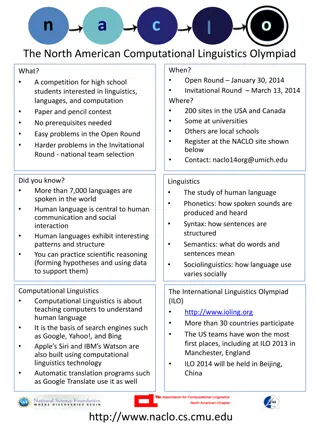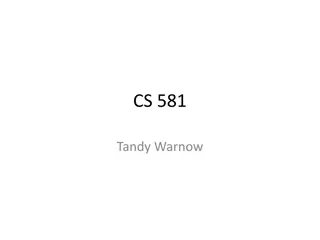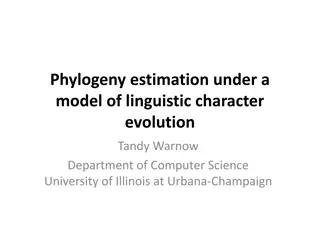Challenges in Computational Linguistic Phylogenetics
This article delves into the challenges and controversies surrounding Indo-European language history, including discussions on subgrouping, the IE homeland, and the life of proto-Indo-European speakers. It explores hypotheses such as the Anatolian and Kurgan theories, estimating dates and homelands of the proto-Indo-Europeans using phylogeny, word reconstruction, and archaeological evidence. Various Indo-European tree models are also examined.
Download Presentation

Please find below an Image/Link to download the presentation.
The content on the website is provided AS IS for your information and personal use only. It may not be sold, licensed, or shared on other websites without obtaining consent from the author.If you encounter any issues during the download, it is possible that the publisher has removed the file from their server.
You are allowed to download the files provided on this website for personal or commercial use, subject to the condition that they are used lawfully. All files are the property of their respective owners.
The content on the website is provided AS IS for your information and personal use only. It may not be sold, licensed, or shared on other websites without obtaining consent from the author.
E N D
Presentation Transcript
Challenges in Computational Linguistic Phylogenetics Tandy Warnow Departments of Computer Science and Bioengineering
Indo-European languages From linguistica.tribe.net
Controversies for IE history Subgrouping: Other than the 10 major subgroups, what is likely to be true? In particular, what about Italo-Celtic Greco-Armenian Anatolian + Tocharian Satem Core (Indo-Iranian and Balto-Slavic) Location of Germanic
Other questions about IE Where is the IE homeland? When did Proto-IE end ? What was life like for the speakers of proto-Indo- European (PIE)?
The Anatolian hypothesis (from wikipedia.org) Date for PIE ~7000 BCE
The Kurgan Expansion Date of PIE ~4000 BCE. Map of Indo-European migrations from ca. 4000 to 1000 BC according to the Kurgan model From http://indo-european.eu/wiki
Estimating the date and homeland of the proto-Indo-Europeans Step 1: Estimate the phylogeny Step 2: Reconstruct words for proto-Indo- European (and for intermediate proto- languages) Step 3: Use archaeological evidence to constrain dates and geographic locations of the proto-languages
Possible Indo-European tree (Ringe, Warnow and Taylor 2000) Anatolian Vedic Greek Italic Iranian Celtic Tocharian Germanic Armenian Baltic Slavic Albanian
Another possible Indo-European tree (Gray & Atkinson, 2004) Italic Gmc. Celtic Baltic Slavic Alb. Indic Iranian Armenian Greek Toch. Anatolian
This talk Linguistic data and the Ringe-Warnow analyses of the Indo-European language family Comparison of different phylogenetic methods on Indo- European datasets (Nakhleh et al., Transactions of the Philological Society 2005) Perfect Phylogenetic Networks (Nakhleh et al., Language 2005) Simulation study evaluating different phylogenetic methods (Barban on et al., Diachronica 2013) Discussion and Future work
The Computational Historical Linguistics Project Collaboration with Don Ringe began in 1994; 17 papers since then, and two NSF grants. Dataset generation by Ringe and Ann Taylor (then a postdoc with Ringe, now Senior Lecturer at York University). Method development with Luay Nakhleh (then my student, now Associate Professor at Rice University), Steve Evans (Prof. Statistics, Berkeley). Simulation study with Francois Barbanson (then my postdoc). Ongoing work in IE with Ringe. http://web.engr.illinois.edu/~warnow/histling.html
Indo-European languages From linguistica.tribe.net
Historical Linguistic Data A character is a function that maps a set of languages, L, to a set of states. Three kinds of characters: Phonological (sound changes) Lexical (meanings based on a wordlist) Morphological (especially inflectional)
Homoplasy-free evolution When a character changes state, it changes to a new state not in the tree; i.e., there is no homoplasy (character reversal or parallel evolution) First inferred for weird innovations in phonological characters and morphological characters in the 19th century, and used to establish all the major subgroups within IE 0 0 1 0 0 0 0 1 1
Sound changes Many sound changes are natural, and should not be used for phylogenetic reconstruction. Others are bizarre, or are composed of a sequence of simple sound changes. These are useful for subgrouping purposes. Example: Grimm s Law. 1. Proto-Indo-European voiceless stops change into voiceless fricatives. 2. Proto-Indo-European voiced stops become voiceless stops. 3. Proto-Indo-European voiced aspirated stops become voiced fricatives.
An Indo-European lexical character: hand. Data. Hittite kissar Lithuanian rank Old Prussian r nkan (acc.) Armenian je n Old English hand Latvian r ka Greek /k :r/ Old Irish l m Gothic handus Albanian dor Latin manus Old Norse h nd Tocharian B ar Luvian ssaris OHG hant Vedic h stas Lycian izredi (instr.) Welsh llaw Avestan zast Tocharian A tsar Oscan manim (acc.) OCS r ka Old Persian dasta Umbrian manf (acc. pl.)
Semantic slot for hand coded (Partitioned into cognate classes)
Proto-Indo-European *plh2meh2flat hand (cf. Homeric Greek palm:) > Proto-Celtic *l m hand > Old Irish l m > Welch llaw Proto-Germanic *handuz hand > Gothic handus > Runic Norse *handu (ending influenced by a different noun class) > Old Norse h nd > Proto-West Germanic *handu > Old English hand > Old High German hant Proto-Italic *man- hand > Latin manus (transferred into the u-stems) > Proto-Sabellian *man- > Oscan *manis > *mans, accusative manim (transf. into the i-stems) > Umbrian *man-, accusative plural manf
Lexical characters can also evolve without homoplasy For every cognate class, the nodes of the tree in that class should form a connected subset - as long as there is no undetected borrowing nor parallel semantic shift. 1 1 1 0 0 0 1 1 2
Our (RWT) Data Ringe & Taylor (2002) 259 lexical 13 morphological 22 phonological These data have cognate judgments estimated by Ringe and Taylor, and vetted by other Indo- Europeanists. (Alternate encodings were tested, and mostly did not change the reconstruction.) Polymorphic characters, and characters known to evolve in parallel, were removed.
Differences between different characters Lexical: most easily borrowed (most borrowings detectable), and homoplasy relatively frequent (we estimate about 25- 30% overall for our wordlist, but a much smaller percentage for basic vocabulary). Phonological: can still be borrowed but much less likely than lexical. Complex phonological characters are infrequently (if ever) homoplastic, although simple phonological characters very often homoplastic. Morphological: least easily borrowed, least likely to be homoplastic.
Our methods/models Ringe & Warnow Almost Perfect Phylogeny : most characters evolve without homoplasy under a no-common- mechanism assumption (various publications since 1995) Ringe, Warnow, & Nakhleh Perfect Phylogenetic Network : extends APP model to allow for borrowing, but assumes homoplasy-free evolution for all characters (Language, 2005) Warnow, Evans, Ringe & Nakhleh Extended Markov model : parameterizes PPN and allows for homoplasy provided that homoplastic states can be identified from the data (Cambridge University Press)
First analysis: Almost Perfect Phylogeny The original dataset contained 375 characters (336 lexical, 17 morphological, and 22 phonological). We screened the dataset to eliminate characters likely to evolve homoplastically or by borrowing. On this reduced dataset (259 lexical, 13 morphological, 22 phonological), we attempted to maximize the number of compatible characters while requiring that certain of the morphological and phonological characters be compatible. (Computational problem NP-hard.)
Indo-European Tree (95% of the characters compatible) Anatolian Vedic Greek Italic Iranian Celtic Tocharian Germanic Armenian Baltic Slavic Albanian
Second attempt: PPN We explain the remaining incompatible characters by inferring previously undetected borrowing . We attempted to find a PPN (perfect phylogenetic network) with the smallest number of contact edges, borrowing events, and with maximal feasibility with respect to the historical record. (Computational problems NP-hard). Our analysis produced one solution with only three contact edges that optimized each of the criteria. Two of the contact edges are well-supported.
Modelling borrowing: Networks and Trees within Networks
Perfect Phylogenetic Networks Problem formulation Input: set of languages described by characters Output: Network on which all characters evolve without homoplasy, but can be borrowed Nakhleh, Ringe, and Warnow, 2005. Language.
Perfect Phylogenetic Network (all characters compatible) Anatolian Vedic Greek Italic Iranian Celtic Tocharian Germanic Armenian Baltic Slavic Albanian L. Nakhleh, D. Ringe, and T. Warnow, LANGUAGE, 2005
Comments This network is very tree-like (only three contact edges needed to explain the data. Two of the three contact edges are strongly supported by the data (many characters are borrowed). If the third contact edge is removed, then the evolution of the remaining (two) incompatible characters needs to be explained. Probably this is parallel semantic shift.
Other IE analyses Note: many reconstructions of IE have been done, but produce different histories which differ in significant ways Possible issues: Dataset (modern vs. ancient data, errors in the cognancy judgments, lexical vs. all types of characters, screened vs. unscreened) Translation of multi-state data to binary data Reconstruction method
Another possible Indo-European tree (Gray & Atkinson, 2004) Italic Gmc. Celtic Baltic Slavic Alb. Indic Iranian Armenian Greek Toch. Anatolian Based only on lexical characters with binary encoding
The performance of methods on an IE data set, Transactions of the Philological Society, L. Nakhleh, T. Warnow, D. Ringe, and S.N. Evans, 2005) Observation: Different datasets (not just different methods) can give different reconstructed phylogenies. Objective: Explore the differences in reconstructions as a function of data (lexical alone versus lexical, morphological, and phonological), screening (to remove obviously homoplastic characters), and methods. However, we use a better basic dataset (where cognancy judgments are more reliable).
Phylogeny reconstruction methods Perfect Phylogenetic Networks (Ringe, Warnow, and Nakhleh) Other network methods Neighbor joining (distance-based method) UPGMA (distance-based method, same as glottochronology) Maximum parsimony (minimize number of changes) Maximum compatibility (weighted and unweighted) Gray and Atkinson (Bayesian estimation based upon presence/absence of cognates, as described in Nature 2003)
Phylogeny reconstruction methods Perfect Phylogenetic Networks (Ringe, Warnow, and Nakhleh) Other network methods Neighbor joining (distance-based method) UPGMA (distance-based method, same as glottochronology) Maximum parsimony (minimize number of changes) Maximum compatibility (weighted and unweighted) Gray and Atkinson (Bayesian estimation based upon presence/absence of cognates, as described in Nature 2003)
Four IE datasets Ringe & Taylor The screened full dataset of 294 characters (259 lexical, 13 morphological, 22 phonological) The unscreened full dataset of 336 characters (297 lexical, 17 morphological, 22 phonological) The screened lexical dataset of 259 characters. The unscreened lexical dataset of 297 characters.
Results: Likely Subgroups Other than UPGMA, all methods reconstruct the ten major subgroups Anatolian + Tocharian (that under the assumption that Anatolian is the first daughter, then Tocharian is the second daughter) Greco-Armenian (that Greek and Armenian are sisters) Nothing else is consistently reconstructed. In particular, the choice of data (lexical only, or also morphology and phonological) has an impact on the final tree. The choice of method also has an impact! differ significantly on the datasets, and from each other.
GA = Gray+Atkinson Bayesian MCMC method * WMC = weighted maximum compatibility MC = maximum compatibility (identical to maximum parsimony on this dataset) NJ = neighbor joining (distance- based method, based upon corrected distance) UPGMA = agglomerative clustering technique used in glottochronology.
Other observations UPGMA (i.e., the tree-building technique for glottochronology) does the worst (e.g. splits Italic and Iranian groups). The Satem Core (Indo-Iranian plus Balto-Slavic) is not always reconstructed. Almost all analyses put Italic, Celtic, and Germanic together: The only exception is Weighted Maximum Compatibility on datasets that include highly weighted morphological characters.ffer significantly on the datasets, and from each other.
Different methods/data give different answers. We don t know which answer is correct. Which method(s)/data should we use?
F. Barbancon, S.N. Evans, L. Nakhleh, D. Ringe, and T. Warnow, Diachronica 2013 Simulation study based on stochastic model of language evolution (Warnow, Evans, Ringe, and Nakhleh, Cambridge University Press 2004) Lexical and morphological characters Networks with 1-3 contact edges, and also trees Moderate homoplasy : morphology: 24% homoplastic, no borrowing lexical: 13% homoplastic, 7% borrowing Low homoplasy : morphology: no borrowing, no homoplasy; lexical: 1% homoplastic, 6% borrowing
Figure 7: Impact of the number of contact edges on phylogenetic reconstruction meth- ods for 300 lexical characters and 60 morphological characters, under two levels of homoplasy (moderate on the left and low on the right). All datasets evolve under a Simulation study sample of results moderate deviation from a lexical clock (dlc = 0.3) and moderate deviation from the rates-across-sites assumption (het = 1.2). Figure 8: Impact of the deviation from the rates-across-sites assumption on phyloge- netic reconstruction methods, for 300 lexical characters and 60 morphological char- acters, under two levels of homoplasy (moderate on the left and low on the right). All characters evolve down a phylogenetic network with three contact edges under a moderate deviation from a lexical clock (dlc = 0.3). We vary het, the parameter for deviating from the rates-across-sites assumption, from low (0.6) to moderate (1.8). Figure 7: Impact of the number of contact edges on phylogenetic reconstruction meth- ods for 300 lexical characters and 60 morphological characters, under two levels of homoplasy (moderate on the left and low on the right). All datasets evolve under a moderate deviation from a lexical clock (dlc = 0.3) and moderate deviation from the rates-across-sites assumption (het = 1.2). Varying number of contact edges Varying deviation from i.i.d. character evolution 4.9 Summary Our study showed the following: There was a consistent pattern of relative accuracy of phylogenies reconstructed using these methods, with UPGMA worst, followed by neighbor joining, then G&A, then MP. The relative performance of WMP and WMC depended upon the amount of homoplasy in the high weight characters, and so was excellent (comparable to that of MP) for the low homoplasy conditions and poor for the moderate homoplasy conditions. Deviating from the lexical clock made all methods somewhat worse, but had the biggest impact on UPGMA. Figure 8: Impact of the deviation from the rates-across-sites assumption on phyloge- netic reconstruction methods, for 300 lexical characters and 60 morphological char- acters, under two levels of homoplasy (moderate on the left and low on the right). All characters evolve down a phylogenetic network with three contact edges under a moderate deviation from a lexical clock (dlc = 0.3). We vary het, the parameter for deviating from the rates-across-sites assumption, from low (0.6) to moderate (1.8). 19 4.9 Summary Our study showed the following: There was a consistent pattern of relative accuracy of phylogenies reconstructed using these methods, with UPGMA worst, followed by neighbor joining, then G&A, then MP. The relative performance of WMP and WMC depended upon the amount of homoplasy in the high weight characters, and so was excellent (comparable to that of MP) for the low homoplasy conditions and poor for the moderate homoplasy conditions. Deviating from the lexical clock made all methods somewhat worse, but had the biggest impact on UPGMA. 19
Observations 1. Choice of data does matter (good idea to add morphological characters, and to screen well). 2. Accuracy only slightly lessened with small increases in homoplasy, borrowing, or deviation from the lexical clock. Some amount of heterotachy (deviation from i.i.d.) improves accuracy. 3. Relative performance between methods consistently shows: Distance-based methods least accurate Gray and Atkinson s method middle accuracy Parsimony and Compatibility methods most accurate
Critique of the Gray and Atkinson model Gray and Atkinson s model is for binary characters (presence/absence), not for multi-state characters. To use their method on multi-state data, they do a binary encoding and so treat a single cognate class as a separate character, and all cognate classes for a single semantic slot are assumed to evolve identically and independently. This assumption is clearly violated by how languages evolve. Note: no rigorous biologist would perform the equivalent treatment on biological data. So this is not about linguistics vs. biologists.
Critique of the Gray and Atkinson model Gray and Atkinson s model is for binary characters (presence/absence), not for multi-state characters. To use their method on multi-state data, they do a binary encoding and so treat a single cognate class as a separate character, and all cognate classes for a single semantic slot are assumed to evolve identically and independently. This assumption is clearly violated by how languages evolve. Note: no rigorous biologist would perform the equivalent treatment on biological data. So this is not about linguistics vs. biology.
Estimating the date and homeland of the proto-Indo-Europeans Step 1: Estimate the phylogeny Step 2: Reconstruct words for proto-Indo- European (and for intermediate proto- languages) Step 3: Use archaeological evidence to constrain dates and geographic locations of the proto-languages
Implications regarding PIE homeland and date Linguists have reconstructed words for wool , horse , thill (harness pole), and yoke , for Proto-Indo-European, for wheel for the ancestor of IE minus Anatolian, and for `axle" to the ancestor of IE minus Anatolian and Tocharian. Archaeological evidence (positive and negative) for these objects used to constrain the date and location for proto-IE to be after the secondary products revolution , and somewhere with horses (wild or domesticated). Combination of evidence supports the date for PIE within 3000-5500 BCE (some would say 3500-4500 BCE), and location not Anatolia, thus ruling out the Anatolian hypothesis.
Our main points Biomolecular data evolve differently from linguistic data, and linguistic models and methods should not be based upon biological models. Better (more accurate) phylogenies can be obtained by formulating models and methods based upon linguistic scholarship, and using good data. Estimating dates at internal nodes requires better models than we have. All current approaches make strong model assumptions that probably do not apply to IE (or other language families). All methods, whether explicitly based upon statistical models or not, need to be carefully tested.
Future research We need more investigation of statistical methods based on good stochastic models, as these are now the methods of choice in biology. This requires realistic parametric models of linguistic evolution and method development under these parametric models!
Modelling issues What are the units? Polymorphism Homoplasy Non-treelike evolution Non-i.i.d. evolution and violations of the rates-across-sites assumption (heterotachy) Deviation from the lexical clock (is dating even really possible?) Note: The statistical model of Warnow, Evans, Ringe, and Nakhleh has homoplasy and reticulation, but no polymorphism. The bag-of-words model of Nicholls and Gray (J R. Statist. Soc.B 2008) allows for polymorphism but no reticulation, and has homoplasy in the form of parallel back- muation. The model of Gray and Atkinson (binary-encoding) has unlimited polymorphism and homoplasy, but no reticulation.
